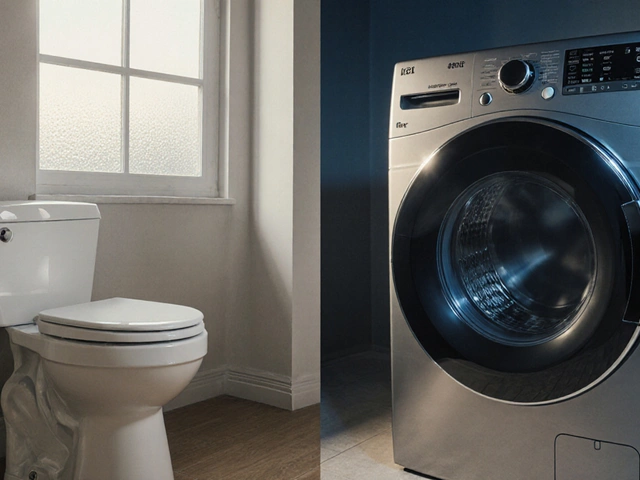Ever had your washing machine stop mid-cycle with a full load of soapy jeans? That always seems to happen right before a big week. Deciding whether to repair it or cut your losses can feel like flipping a coin, but it doesn’t have to be a gamble.
Start with the facts: most washers last anywhere from 8 to 12 years. If yours is in that range and isn’t acting up much, a repair could be a smart move that saves you cash. But if the thing’s clanging like a freight train and leaking all over your socks, it might be time to rethink pouring more money into it.
Before you shell out for a service call, check a few basic things. Is the power cord plugged in all the way? Have you made sure the circuit breaker didn’t trip? Sometimes it’s as simple as an off-balance load—or a kid’s sock wedged in the door. Taking five minutes to look could save you a hundred bucks and an eye-roll from the repair guy.
- Common Reasons Washing Machines Fail
- When Repair Makes Sense (And When It Doesn't)
- Understanding Typical Repair Costs
- DIY Fixes and Troubleshooting Tips
- How to Stretch the Life of Your Washer
Common Reasons Washing Machines Fail
Most washing machines don’t just quit out of nowhere. There’s usually a reason—sometimes pretty obvious, sometimes hiding under the surface. If you know the usual suspects, you can often tell right away if something’s simple to fix, or if your washer’s days might be numbered.
- Washing machine repair calls mostly come from leaks, weird banging noises, or spinning problems. A leaking machine could mean a cracked hose, worn-out door seal, or even a loose clamp inside.
- If your washer won’t spin or drain, it could just be a clogged pump, a broken lid switch, or maybe a bad drive belt. These parts wear out over time—nothing unusual about it.
- Loud noises often come from coins, buttons, or zippers stuck in the drum, but they can also signal worn drum bearings or a busted shock absorber. You’ll hear the difference: clunks and grinding mean business.
- Electrical gremlins show up as the machine not powering on or stopping mid-cycle. Sometimes it’s a blown fuse or a fried main control board.
- Funky smells aren’t just annoying—they usually point to mold or mildew growing somewhere inside, most often in front-loader door gaskets.
Here’s a quick look at what usually goes wrong, and how often:
| Problem | Percentage of Service Calls |
|---|---|
| Won't Drain or Spin | 34% |
| Leaks | 27% |
| Loud Noises | 19% |
| Won't Start | 13% |
| Bad Smells | 7% |
Most of these issues have a clear fix, especially if you catch them early. Pay attention to sounds, leaks, or cycles cutting short, and you’ll spot trouble before it turns into a wallet-busting disaster.
When Repair Makes Sense (And When It Doesn't)
Not all washing machine breakdowns mean you’ve got to hit the store for a new one, but sometimes it just isn’t worth the hassle. So, how do you figure it out?
Start by looking at your washer’s age. If it’s less than eight years old and hasn’t caused much trouble before, fixing it is usually the smart call—especially if you like how it washes and it's been trouble-free until now. Most top brands (like Whirlpool, LG, and Maytag) can run well past a decade if you keep up with simple maintenance.
Next, think about the type of problem. Simple stuff like a broken belt, clogged filter, or faulty switch is usually cheap and quick to fix. Even replacing a water pump or inlet valve costs way less than a new washer. But if you hear that dreaded phrase—"it needs a new control board"—get ready for sticker shock. Computerized parts, transmission, or drum repairs can run hundreds of bucks, almost the price of a new model.
- If a washing machine repair will cost you over half the price of buying new—especially if it’s already several years old—don’t waste your money; replacement is usually the smarter move.
- If your washer is still under manufacturer or extended warranty, get the repair done. You already paid for the coverage.
- Frequent breakdowns (even small ones) are a red flag. If you’re calling for service more than once a year, add up what you’ve spent—it often surprises people that it’s more than a budget washer would cost.
One thing most people forget? Newer machines use less water and energy. This means even if you pay a bit more upfront for a new washer, your utility bills might actually go down every month.

Understanding Typical Repair Costs
Let’s talk real numbers, because nobody wants to get blindsided by a repair bill. The average washing machine repair runs anywhere from $150 to $400, depending on what’s busted. Replacing a simple belt or lid switch might set you back just $100. If it’s something bigger, like a motor or control board, you could be staring at a $350 to $500 invoice. That stings, especially if your washer wasn’t all that pricey to begin with.
Here’s a quick breakdown so you know what to expect when the repair guy starts throwing out prices:
- Belt or agitator issues: $90–$150
- Drain pump problems: $120–$250
- Water inlet valve: $100–$200
- Motor replacement: $250–$500
- Control board: $300–$400
Most service calls have a flat fee just to show up, usually between $60 and $100. That fee sometimes goes toward the total repair if you hire them, but it’s still money out of your pocket if you decide to skip the repair.
One easy trick: check your washer’s age and compare the repair cost to half the price of a new one. If the fix costs more than 50% of buying a replacement, it’s usually smarter to buy new. Sometimes, older machines just aren’t worth sinking money into.
Always ask about part warranties and labor guarantees, too. Some shops back up their work for 90 days or more. If someone’s charging a ton and won’t stand behind the job, that’s a red flag.
Bottom line—knowing these repair numbers puts you in the driver’s seat, so you don’t overpay or get talked into fixing something that should be replaced. Your washing machine repair decision really comes down to those numbers.
DIY Fixes and Troubleshooting Tips
Before you call a pro, there are a bunch of things you can check or fix yourself. Most washing machine problems boil down to something surprisingly basic. Even if you’re not handy, a little troubleshooting can save a chunk of change.
First off, always unplug your washer before poking around. Getting zapped or splashed isn’t anyone’s idea of a good time.
- Washing machine repair tip #1: Won’t start? Check if the power cord is snug. Also, peek at your home’s breaker box—washers can trip breakers if you’ve got too much running at once.
- Won’t drain? Lint and small items love to hide in drain pumps and hoses. Remove the back panel or bottom front panel and check for clogs. Pennies, bobby pins, and stray socks show up all the time.
- Loud banging or crazy vibrations? Make sure your washer is sitting level. All four feet should touch the floor. Stick a level on top if you’re not sure, and adjust the feet by twisting them.
- Leaking water? Door gaskets sometimes get coated in gunk, which keeps them from sealing tight. Give the rubber seal a good wipe and check for tears.
- Strange smells? Try running a hot cleaning cycle with two cups of white vinegar. Mold can build up where you can’t see it, especially in the detergent tray and door seals.
If you’re wondering how likely it is you’ll stumble on a quick fix, check out this:
| Problem | Common DIY Fix Found | Average Time to Fix |
|---|---|---|
| Won’t Start | Loose plug, breaker | 2-5 min |
| Won’t Drain | Clogged hose, pump trap | 10-20 min |
| Loud Noises | Unleveled feet, loose items | 10 min |
| Leaking | Dirty gasket, hose clamp | 10-15 min |
| Odor | Vinegar wash | 60 min (cycle time) |
Nothing working? Sometimes it’s just a faulty lid switch or a worn-out water inlet valve. You can order those online and swap them with ordinary tools. There are tons of repair videos that show exactly what to do, so you’re not flying blind. Just make sure you’ve got the right part for your washer’s brand and model.
If you run into a problem you can’t pin down, or you see burning smells or sparks, it’s time to hit pause and call a pro. Some repairs are just not worth the risk or extra headaches.

How to Stretch the Life of Your Washer
Want your washer to stick around longer? How you treat it actually makes a bigger difference than you’d think. Most issues that lead to big repair bills start with the little stuff people ignore.
First, stop overloading it. Cramming in too many towels or jeans strains the motor, bearings, and suspension. That stress shortens your washer’s lifespan by years. Most user manuals (yeah, that little book you probably tossed) say to keep loads at most three-quarters full—never jam them to the very top.
Now, about those cleaning cycles. Most modern washers have a tub clean function. Run it monthly with a washer cleaner tablet or just some hot water and white vinegar. This clears out soap scum, mold, and gunk way before it turns into a bigger problem. If your washer smells like a wet dog, it’s begging for a cleaning.
- Leave the door open when you’re done for the day—this helps the inside dry out and stops mildew.
- Check and clean your washer filter (usually at the front, near the bottom). Lint, coins, and hairpins love getting stuck there and can actually burn out the pump if left alone.
- Inspect hoses every couple years for bulges or cracks. A busted hose can flood your laundry room and ruin more than just your day.
Don’t skip leveling. If your washer shakes or walks across the floor, it puts extra wear on important parts and could even break your machine sooner. Adjust those little feet under the frame until it sits steady, then check occasionally if your floor tends to shift or settle.
Want a snapshot?
| Washer Care Habit | How Often | Why It Matters |
|---|---|---|
| Clean drum & run tub cycle | Monthly | Stops buildup and odors |
| Check hoses for cracks/leaks | Every 6 months | Prevents flooding |
| Clean filter/trap | Monthly | Keeps pump running right |
| Level the machine | Yearly or as needed | Avoids extra wear and noise |
If you follow these steps, your washing machine repair costs should drop, and you can dodge the headache that comes with a dead appliance mid-laundry day. No one wants to dig through backup underwear because their washer died early.




